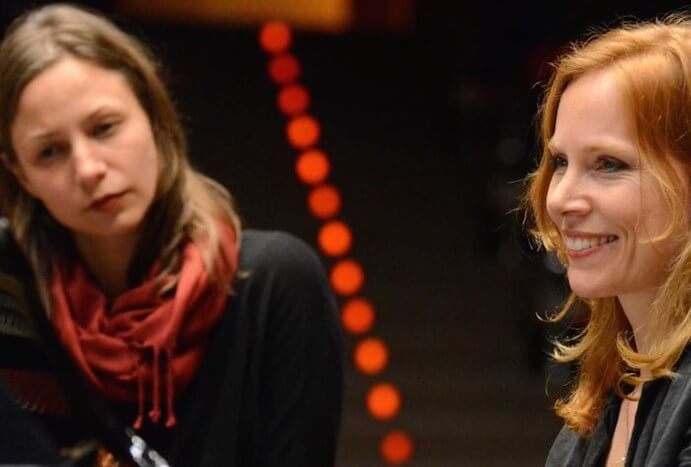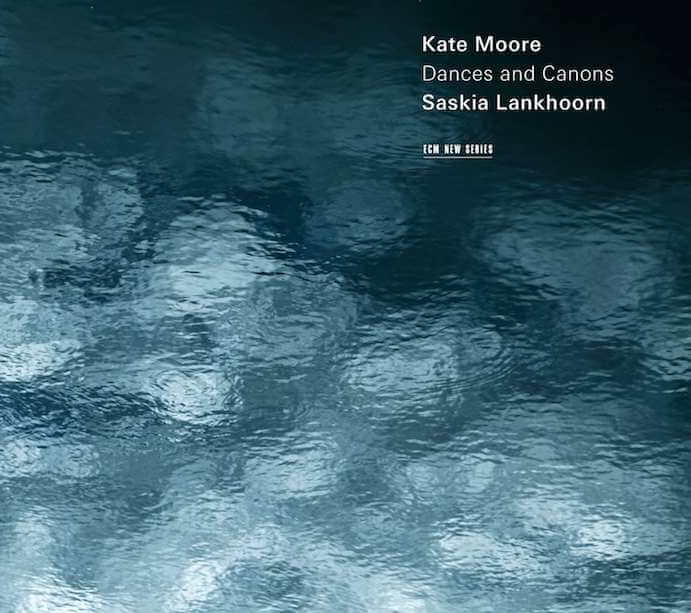Perceiving and thinking about the way things change, we can sometimes pierce through to the elemental and constant. Vast distances of unpredictable disturbances, both minuscule and grand, dot the landscape of Kate Moore‘s newest record Dances and Canons on the ECM New Series imprint, contributing nicely to the German label’s persistent sonic experimentation. Pianist Saskia Lankhoorn‘s presentation of this collection of Moore’s works written throughout the last decade appear in both pristine fidelity and encompassing interpretation. With music that is at once abstract, melodic, and quasi-‘minimalist’ (Moore rejects the term as an anachronism), we are able to momentarily drop into something delicate but exuberant; powerful and reassuringly complete in its enclosed form– the form of the Canon– a form which takes itself as its own point of departure. Conceptually aligned with mystic approaches (the writings of Hazrat Inayat Khan in particular), these sixty-eight minutes of the piano’s dependable yet surprising sound (sometimes doubled, sometimes quadrupled via pre-recorded playback in combination with Lankhoorn’s simultaneous performance) serve as a window into the exotic landscapes which permeate the the expressions of this composer who lives between geographical worlds and their embodied attitudes.
Sound as a manifestation of vibration, whereby we come to understand the one-ness in all things through its affective power over heart and soul, is a core Sufi understanding which Moore has synthesized into her environmental compositional process for this set of pieces, which demand that their expression of surface features be taken absolutely seriously on their own terms. Something that feels metal and pointy will gradually (or suddenly!) change into a relatively staid equilibrium. There is sense of constant wandering which both the performer and listener must negotiate. For the listener, this is a struggle viewed in retrograde, but for Lankhoorn, who is called-upon to perform ‘un-memorizable’ tasks, such as playing whole sections in exactly the same manner multiple times as previous renditions are played back, the struggle occurs in realtime and produces a vanishing point that Moore has designed to manifest. Much of the sonic chemistry of this music is evocative of endless landscapes, and one can almost visually conjure their spans and temporalities. The land of Moore’s upbringing, Australia, is one where nothing seems to match previous experience. The very texture of the land is alien, ancient, worn– a land often sun-scorched and ungiving.

Kate Moore–Photo by Johan Nieuwenhuize
Yet Moore’s work as a composer exists within transitions; in her music they are the moments when a stable oscillation evolves into a proliferating, iterative sea of hybrids; in her life they are the junctures between hemispheres, between the hostile and endless parched plains of Australia to the green and gentle lands of Holland, where Moore has studied with composer Louis Andriessen, the co-founder of STEIM in Amsterdam and who is stylistically noted for his post-European avant-garde minimalist works that use unconventional ensembles. It is here in Holland that she too forged her working relationship with Lankhoorn, who delivers shapely purpose to the forceful rhythms of Moore’s time-lapse models of cascading interferences. What lies beyond the vanishing point? The impossibility of performing something in exactly the same way produces a multitude of humanizing delays, which get lost in closures and incorporations over time. The process reveals Moore’s preference to music that remains synced to our regular time, one which is connected to the natural world, with its gradients of imperfection. They form vistas that are gradually joined by melodic lines multiplying and mutating their rhythm. Asserting its physical makeup in this way, the repeated figures become the composite of a dense texture, full of a surplus of embellishments and neighboring dissonances that sometimes resolve, and other times dismantle the entire passage through their decentralization. It is this wonderful utilization of playback that Moore, with her own techniques of overdubbing, has drawn upon and refined in many of her previous instrumental works.

Kate Moore and Saskia Lankhoorn.
In pieces like Canon one hears motion, as objects move from one location to another, and then back to their starting positions. But the constant returning and leaving proves effectively hypnotizing, carrying the listener into their own latticework of internal memory. The effect is hard to describe, but Moore is such a natural with her melodic components that things never feel stretched, despite the relentless recycling of musical fragments. The Body Is An Ear, for two pianos, possesses a tangible sense of parts interlocking, with Lankhoorn’s steadfast internal metronome giving rise to lush resonances of difference tones clashing with and against one another. Moore’s sense of tension, heard in her deliberately ‘wrong’ notes and dissonant tones that interject over established ostinato patterns are remarkably fresh and evocative, alluding to the dazzling stacked harmonies of her European mentors. While these periods of transition are marked by excitement, experimentation, and resistance, Moore seeks paths of smooth consonance to balance against the terror of the endless landscape. It is a journey worth revisiting again and again, if only for the calming effects of the timescapes like those encountered in nature, where all the variables and dramas of individual life dissolve away to reveal something greater.





















